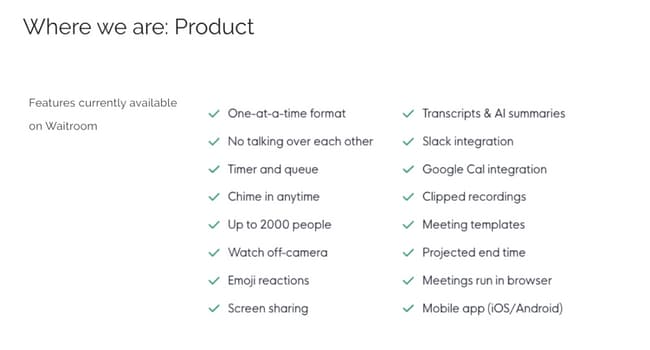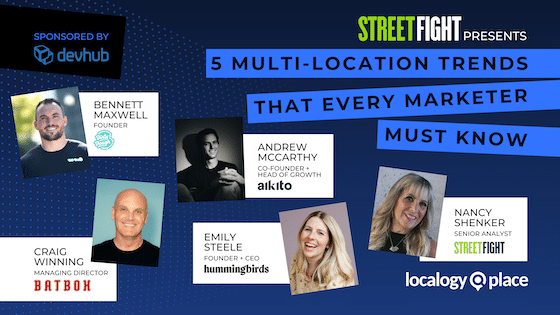Last March we wrote about a startup focused on online meetings called Waitroom, founded by serial tech entrepreneur Vinny Lingham.
Lingham is a well-known figure in the crypto world. He is the executive chairman of Civic, a blockchain identity firm that he co-founded. Now based in California, Lingham has remained connected to his home country as a shark on the South African version of Shark Tank. Lingham is also the General Partner of Cape Town-based VC firm Newtown Partners.
Lingham will be a speaker at Localogy’s L23 Conference next month in San Diego.
Lingham’s other past online startup adventures include co-founding the freemium website builder Yola and the mobile gift card company Gyft.
Waitroom was re-launched this week with a new focus and features (including AI tools). The company now sits squarely among startups that are determined to make online business meetings — something everyone seems to hate — better, more efficient, more productive, and so on.
This space is also inhabited by Howard Lerman’s Roam, and David Shim’s Read AI, among others.
As we wrote last year, Waitroom started out as a platform to make it easier for business influencers to meet with their followers. And the key was that the meetings be short and productive. This idea came from Lingham’s own experience as a business influencer, where it was difficult to structure short online meetings.
The original “waitroom” angle involved a sequence of very short interactions with people gathered in an online room waiting their turn to meet 1:1 with someone like Vinny to seek advice, pitch ideas, etc., but in a structured, time-limited format.
Version 2.0
Last year we said Waitroom would inevitably pivot from the initial influencer play into an enterprise play that competes with the Zooms of the world.
This is what we wrote a year ago.
“We imagine if Waitroom ultimately succeeds it will be more as an everyday alternative to Zoom than as a platform for meetings with business celebrities. The steak will eventually have to take over from the sizzle.”
And this week’s relaunch is pretty consistent with this view that we expressed when we first introduced Localogy Insider readers to Waitroom.
We had a chat last week with Vinny, who walked us through the decision to relaunch Waitroom. And how Waitroom 2.0 differs from the initial version.
Twitter Spaces Meets Zoom
Lingham describes the new version of Waitroom as “Twitter spaces meet Zoom.” Waitroom’s key pivot is from focusing on business influencers to making company meetings better and more productive.
The company describes this pivot as “user-driven”. In other words, as they rolled out Waitroom 1.0, the Waitroom discovered the use case was stronger in the business world than the original vision assumed. The original vision emanated very closely from Vinny’s personal experiences with demands on his time as an entrepreneur and business influencer.

Notably, the default 30-minute meeting time appears to be a focal point of what is widely considered wrong with online meetings. Howard Lerman has honed in on this glaring inefficiency as he has made the case for his Roam “Cloud HQ” startup. Lerman says one big benefit of the Roam platform is that it reduces the average meeting length to 8:34.
Waitroom seeks to improve online meetings with the addition of new features designed to cut out the things that make meetings awful (e.g. cross-talk). And use AI tools (hence the comparison to Shim’s Read AI) to optimize the valuable things that meetings produce. Waitroom will do this by producing AI transcripts that can be mined for accountability, follow-ups, action items, etc.
When we spoke to Vinny last week, he said that Waitroom’s key target market now is what he described as “smallish companies with a couple of hundred employees.” Though he did say that much smaller companies that conduct a lot of online meetings are good targets as well.
Underlying Waitroom’s vision for online meetings is the firm belief that “AI is going to disrupt the video conferencing world.” Every day that passes seems to make this statement at least feel truer, if not inevitable.

Crypto Angle
Given Lingham’s association with blockchain and crypto, it’s no surprise that there is a blockchain angle to Waitroom. Vinny told us last week that one of Waitroom’s investors is Protocol Labs, best known for the Filecoin decentralized data storage protocol and cryptocurrency.
This will be key to one of Waitroom V2’s key differentiators — lower data storage costs than competitors offer.
Lingham told us that Waitroom will use this protocol “to store vast amounts of recordings that companies produce at very low costs.”
When Waitroom launched last year we reported that the company had raised a $3 million initial round. Vinny told us last week that the company had just raised a “little bit of extra cash.” He said the company would probably go out for more funding later this year.
A Conversation with Vinny
Below are a few brief highlights from our conversation last week with Vinny Lingham about the relaunch of Waitroom and the broken culture of online meetings.
Q: How would you quickly describe the new Waitroom?
A: It’s like Twitter Spaces meet Zoom. The thing that makes Twitter Spaces and Clubhouse so powerful is that people don’t want to be on camera, but they want to contribute to the conversation. And then you’ve got people who want to be on camera. And so we have the best of both worlds.
Q: How are you trying to change meetings and what is the role of AI?
A: We are trying to change meeting culture, that’s what we’re trying to do. So that everyone gets to say what they need to say and move on. You capture it all into an AI system that has all this information and valuable output. The meeting should be the input. And the output is all these action items, tasks, follow-ups, reminders, all these things. So it’s no longer just static meetings. It’s intelligent meetings.
Q: Will your product enable a culture of fewer meetings?
I would say more engagement and less time. Because what I think will happen is, if people start seeing how powerful this product is, they will go from having one hour-long meeting to maybe four 10-minute meetings. So they’re going to save time. The number of meetings may go up, but your engagement time is shorter per meeting.




